Quantum Tunneling of Particles through Potential Barriers
Last updatedJan 20, 2020
Contributed by OpenStax
General Physics at OpenStax CNX
LEARNING OBJECTIVES
By the end of this section, you will be able to:
Describe how a quantum particle may tunnel across a potential barrier
Identify important physical parameters that affect the tunneling probability
Identify the physical phenomena where quantum tunneling is observed
Explain how quantum tunneling is utilized in modern technologies
Quantum tunneling is a phenomenon in which particles penetrate a potential energy barrier with a height greater than the total energy of the particles. The phenomenon is interesting and important because it violates the principles of classical mechanics. Quantum tunneling is important in models of the Sun and has a wide range of applications, such as the scanning tunneling microscope and the tunnel diode.
Tunneling and Potential Energy
To illustrate quantum tunneling, consider a ball rolling along a surface with a kinetic energy of 100 J. As the ball rolls, it encounters a hill. The potential energy of the ball placed atop the hill is 10 J. Therefore, the ball (with 100 J of kinetic energy) easily rolls over the hill and continues on. In classical mechanics, the probability that the ball passes over the hill is exactly 1—it makes it over every time. If, however, the height of the hill is increased—a ball placed atop the hill has a potential energy of 200 J—the ball proceeds only part of the way up the hill, stops, and returns in the direction it came. The total energy of the ball is converted entirely into potential energy before it can reach the top of the hill. We do not expect, even after repeated attempts, for the 100-J ball to ever be found beyond the hill. Therefore, the probability that the ball passes over the hill is exactly 0, and probability it is turned back or “reflected” by the hill is exactly 1. The ball never makes it over the hill. The existence of the ball beyond the hill is an impossibility or “energetically forbidden.”
However, according to quantum mechanics, the ball has a wave function and this function is defined over all space. The wave function may be highly localized, but there is always a chance that as the ball encounters the hill, the ball will suddenly be found beyond it. Indeed, this probability is appreciable if the “wave packet” of the ball is wider than the barrier.
View this interactive simulation for a simulation of tunneling.
In the language of quantum mechanics, the hill is characterized by a potential barrier. A finite-height square barrier is described by the following potential-energy function:
U(x)=⎧⎩⎨⎪⎪⎪⎪0,U0,0,when x<0when 0≤x≤Lwhen x>L(7.7.1)(7.7.1)U(x)={0,when x<0U0,when 0≤x≤L0,when x>L
The potential barrier is illustrated in Figure 7.7.17.7.1. When the height U0U0 of the barrier is infinite, the wave packet representing an incident quantum particle is unable to penetrate it, and the quantum particle bounces back from the barrier boundary, just like a classical particle. When the width LL of the barrier is infinite and its height is finite, a part of the wave packet representing an incident quantum particle can filter through the barrier boundary and eventually perish after travelling some distance inside the barrier.
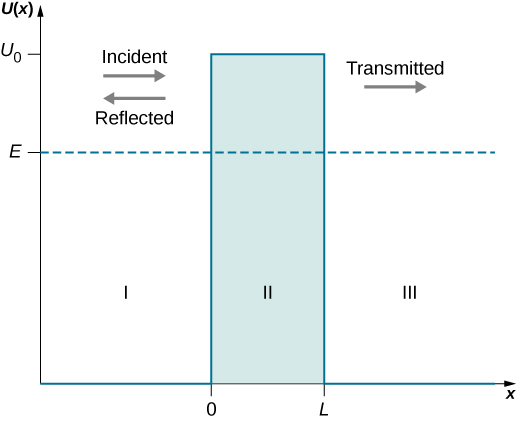
Figure 7.7.17.7.1: A potential energy barrier of height U0U0 creates three physical regions with three different wave behaviors. In region I where x<0x<0, an incident wave packet (incident particle) moves in a potential-free zone and coexists with a reflected wave packet (reflected particle). In region II, a part of the incident wave that has not been reflected at x=0x=0 moves as a transmitted wave in a constant potential U(x)=+U0U(x)=+U0 and tunnels through to region III at x=Lx=L. In region III for x>Lx>L, a wave packet (transmitted particle) that has tunneled through the potential barrier moves as a free particle in potential-free zone. The energy E of the incident particle is indicated by the horizontal line.
When both the width LL and the height U0U0 are finite, a part of the quantum wave packet incident on one side of the barrier can penetrate the barrier boundary and continue its motion inside the barrier, where it is gradually attenuated on its way to the other side. A part of the incident quantum wave packet eventually emerges on the other side of the barrier in the form of the transmitted wave packet that tunneled through the barrier. How much of the incident wave can tunnel through a barrier depends on the barrier width LL and its height U0U0, and on the energy EE of the quantum particle incident on the barrier. This is the physics of tunneling.
Barrier penetration by quantum wave functions was first analyzed theoretically by Friedrich Hund in 1927, shortly after Schrӧdinger published the equation that bears his name. A year later, George Gamow used the formalism of quantum mechanics to explain the radioactive αα-decay of atomic nuclei as a quantum-tunneling phenomenon. The invention of the tunnel diode in 1957 made it clear that quantum tunneling is important to the semiconductor industry. In modern nanotechnologies, individual atoms are manipulated using a knowledge of quantum tunneling.
Tunneling and the Wavfunction
Suppose a uniform and time-independent beam of electrons or other quantum particles with energy EE traveling along the x-axis (in the positive direction to the right) encounters a potential barrier described by Equation 7.7.17.7.1. The question is: What is the probability that an individual particle in the beam will tunnel through the potential barrier? The answer can be found by solving the boundary-value problem for the time-independent Schrӧdinger equation for a particle in the beam. The general form of this equation is given by Equation 7.7.27.7.2, which we reproduce here:
−ℏ22md2ψ(x)dx2+U(x)ψ(x)=Eψ(x),(7.7.2)(7.7.2)−ℏ22md2ψ(x)dx2+U(x)ψ(x)=Eψ(x),
where −∞<x<+∞−∞<x<+∞.
The potential function U(x)U(x) in Equation 7.7.27.7.2 is defined by Equation 7.7.17.7.1. We assume that the given energy EE of the incoming particle is smaller than the height U0U0 of the potential barrier, E<U0E<U0, because this is the interesting physical case. Knowing the energy EE of the incoming particle, our task is to solve Equation 7.7.27.7.2 for a function ψ(x)ψ(x) that is continuous and has continuous first derivatives for all x. In other words, we are looking for a “smooth-looking” solution (because this is how wave functions look) that can be given a probabilistic interpretation so that |ψ(x)|2=ψ∗(x)ψ(x)|ψ(x)|2=ψ∗(x)ψ(x) is the probability density.
We divide the real axis into three regions with the boundaries defined by the potential function in Equation 7.7.17.7.1 (illustrated in Figure 7.7.17.7.1) and transcribe Equation 7.7.27.7.2 for each region. Denoting by ψI(x)ψI(x) the solution in region II for x<0x<0, by ψII(x)ψII(x) the solution in region IIII for 0≤x≤L0≤x≤L, and by ψIII(x)ψIII(x) the solution in region IIIIII for x>Lx>L, the stationary Schrӧdinger equation has the following forms in these three regions:
−ℏ22md2ψI(x)dx2=EψI(x),(7.7.3)(7.7.3)−ℏ22md2ψI(x)dx2=EψI(x),
in region II: −∞<x<0,−∞<x<0,
−ℏ22md2ψII(x)dx2+U0ψII(x)=EψII(x)(7.7.4)(7.7.4)−ℏ22md2ψII(x)dx2+U0ψII(x)=EψII(x)
in region IIII: 0<x<L,0<x<L,
−ℏ22md2ψIII(x)dx2=EψIII(x)(7.7.5)(7.7.5)−ℏ22md2ψIII(x)dx2=EψIII(x)
in region IIIIII: L<x<+∞,L<x<+∞,
The continuity condition at region boundaries requires that:
ψI(0)=ψII(0)(7.7.6)(7.7.6)ψI(0)=ψII(0)
at the boundary between regions II and IIII
and
ψII(L)=ψIII(L)(7.7.7)(7.7.7)ψII(L)=ψIII(L)
at the boundary between regions IIII and IIIIII.
The “smoothness” condition requires the first derivative of the solution be continuous at region boundaries:
dψI(x)dx∣∣∣x=0=dψII(x)dx∣∣∣x=0(7.7.8)(7.7.8)dψI(x)dx|x=0=dψII(x)dx|x=0
at the boundary between regions II and IIII
and
dψII(x)dx∣∣∣x=L=dψIII(x)dx∣∣∣x=L(7.7.9)(7.7.9)dψII(x)dx|x=L=dψIII(x)dx|x=L
at the boundary between regions IIII and IIIIII.
In what follows, we find the functions ψI(x),ψII(x)ψI(x),ψII(x), and ψIII(x)ψIII(x).
We can easily verify (by substituting into the original equation and differentiating) that in regions II and IIIIII, the solutions must be in the following general forms:
ψI(x)=Ae+ikx+Be−ikx(7.7.10)(7.7.10)ψI(x)=Ae+ikx+Be−ikx
ψIII(x)=Fe+ikx+Ge−ikx(7.7.11)(7.7.11)ψIII(x)=Fe+ikx+Ge−ikx
where k=2mE−−−−√/ℏk=2mE/ℏ is a wave number and the complex exponent denotes oscillations,
e±ikx=coskx±isinkx.(7.7.12)(7.7.12)e±ikx=coskx±isinkx.
The constants AA, BB, FF, and GG in Equations 7.7.107.7.10 and 7.7.117.7.11 may be complex. These solutions are illustrated in Figure 7.7.27.7.2. In region I, there are two waves—one is incident (moving to the right) and one is reflected (moving to the left)—so none of the constants AA and BB in Equation 7.7.107.7.10 may vanish. In region III, there is only one wave (moving to the right), which is the transmitted wave, so the constant GG must be zero in Equation 7.7.117.7.11, G=0G=0. We can write explicitly that the incident wave is ψin(x)=Ae+ikxψin(x)=Ae+ikx and that the reflected wave is ψref(x)=Be−ikxψref(x)=Be−ikx, and that the transmitted wave is
ψtra(x)=Fe+ikxψtra(x)=Fe+ikx. The amplitude of the incident wave is
\begin{align*}|\psi_{in}(x)|^2 &= \psi_{in}^*(x)\psi_{in}(x) \\[4pt &= (Ae^{+ikx})^*Ae^{+ikx} \\[4pt] = A^*e^{-ikx}Ae^{+ikx} \\[4pt] &= A^*A = |A|^2. \end{align*}\begin{align*}|\psi_{in}(x)|^2 &= \psi_{in}^*(x)\psi_{in}(x) \\[4pt &= (Ae^{+ikx})^*Ae^{+ikx} \\[4pt] = A^*e^{-ikx}Ae^{+ikx} \\[4pt] &= A^*A = |A|^2. \end{align*}
Similarly, the amplitude of the reflected wave is |ψref(x)|2=|B|2|ψref(x)|2=|B|2 and the amplitude of the transmitted wave is |ψtra(x)|2=|F|2|ψtra(x)|2=|F|2. We know from the theory of waves that the square of the wave amplitude is directly proportional to the wave intensity. If we want to know how much of the incident wave tunnels through the barrier, we need to compute the square of the amplitude of the transmitted wave. The transmission probability or tunneling probability is the ratio of the transmitted intensity (|F|2|F|2) to the incident intensity (|A|2|A|2), written as
T(L,E)=|ψtra(x)|2|ψin(x)|2=|F|2|A|2=∣∣∣FA∣∣∣2(7.7.13)(7.7.14)(7.7.15)(7.7.13)T(L,E)=|ψtra(x)|2|ψin(x)|2(7.7.14)=|F|2|A|2(7.7.15)=|FA|2
where LL is the width of the barrier and EE is the total energy of the particle. This is the probability an individual particle in the incident beam will tunnel through the potential barrier. Intuitively, we understand that this probability must depend on the barrier height U0U0.
In region II, the terms in equation Equation 7.7.47.7.4 can be rearranged to
d2ψII(x)dx2=β2ψII(x)(7.7.16)(7.7.16)d2ψII(x)dx2=β2ψII(x)
where β2β2 is positive because U0>EU0>E and the parameter ββ is a real number,
β2=2mℏ2(U0−E).(7.7.17)(7.7.17)β2=2mℏ2(U0−E).
The general solution to Equation 7.7.167.7.16 is not oscillatory (unlike in the other regions) and is in the form of exponentials that describe a gradual attenuation of ψII(x)ψII(x),
ψII(x)=Ce−βx+De+βx.(7.7.18)(7.7.18)ψII(x)=Ce−βx+De+βx.
The two types of solutions in the three regions are illustrated in Figure 7.7.27.7.2.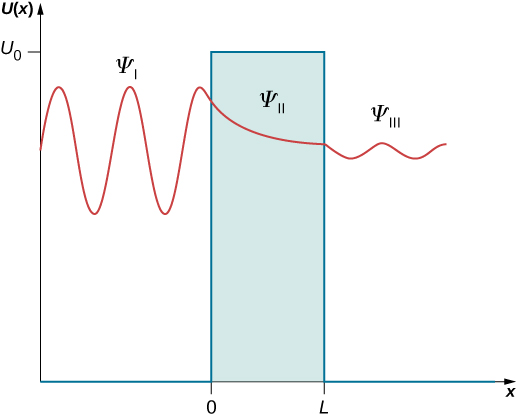

Figure 7.7.27.7.2: Three types of solutions to the stationary Schrӧdinger equation for the quantum-tunneling problem: Oscillatory behavior in regions I and III where a quantum particle moves freely, and exponential-decay behavior in region II (the barrier region) where the particle moves in the potential U0U0.
Now we use the boundary conditions to find equations for the unknown
constants. Equations 7.7.107.7.10 and 7.7.187.7.18 are substituted into Equation 7.7.67.7.6 to give
A+B=C+D.(7.7.19)(7.7.19)A+B=C+D.
Equations 7.7.187.7.18 and 7.7.117.7.11 are substituted into Equation 7.7.77.7.7 to give
Ce−βL+De+βL=Fe+ikL.(7.7.20)(7.7.20)Ce−βL+De+βL=Fe+ikL.
Similarly, we substitute Equations 7.7.107.7.10 and 7.7.187.7.18 into Equation 7.7.87.7.8, differentiate, and obtain
−ik(A−B)=β(D−C).(7.7.21)(7.7.21)−ik(A−B)=β(D−C).
Similarly, the boundary condition Equation 7.7.97.7.9 reads explicitly
β(De+βL−Ce−βL)=+ikFe+ikL.(7.7.22)(7.7.22)β(De+βL−Ce−βL)=+ikFe+ikL.
We now have four equations for five unknown constants. However, because the quantity we are after is the transmission coefficient (TT), defined in Equation 7.7.157.7.15 by the fraction F/AF/A, the number of equations is exactly right because when we divide each of the above equations by AA, we end up having only four unknown fractions: B/AB/A, C/AC/A, D/AD/A, and F/AF/A, three of which can be eliminated to find F/AF/A. The actual algebra that leads to expression for F/AF/A is pretty lengthy, but it can be done either by hand or with a help of computer software. The end result is
FA=e−ikLcosh(βL)+i(γ/2)sinh(βL).(7.7.23)(7.7.23)FA=e−ikLcosh(βL)+i(γ/2)sinh(βL).
In deriving Equation 7.7.237.7.23, to avoid the clutter, we use the substitutions γ≡β/k−k/βγ≡β/k−k/β, and the definition of hyperbolic functions:
coshy=ey+e−y2(7.7.24)(7.7.24)coshy=ey+e−y2
and
sinhy=ey−e−y2.(7.7.25)(7.7.25)sinhy=ey−e−y2.
We substitute Equation 7.7.237.7.23 into Equation 7.7.157.7.15 and obtain the exact expression for the transmission coefficient for the barrier,
T(L,E)=(FA)∗FA=e+ikLcosh(βL)−i(γ/2)sinh(βL)⋅e−ikLcosh(βL)+i(γ/2)sinh(βL).(7.7.26)(7.7.26)T(L,E)=(FA)∗FA=e+ikLcosh(βL)−i(γ/2)sinh(βL)⋅e−ikLcosh(βL)+i(γ/2)sinh(βL).
or
T(L,E)=1cosh2(βL)+(γ/2)2sinh2(βL).(7.7.27)(7.7.27)T(L,E)=1cosh2(βL)+(γ/2)2sinh2(βL).
where
(γ2)2=14(1−E/U0E/U0+E/U01−E/U0−2).(7.7.28)(7.7.28)(γ2)2=14(1−E/U0E/U0+E/U01−E/U0−2).
For a wide and high barrier that transmits poorly, Equation 7.7.277.7.27 can be approximated by
T(L,E)≈16EU0(1−EU0)e−2βL.(7.7.29)(7.7.29)T(L,E)≈16EU0(1−EU0)e−2βL.
Whether it is the exact expression (Equation 7.7.277.7.27) or the approximate expression (Equation 7.7.297.7.29), we see that the tunneling effect very strongly depends on the width LL of the potential barrier. In the laboratory, we can adjust both the potential height U0U0 and the width LL to design nano-devices with desirable transmission coefficients.
EXAMPLE 7.7.17.7.1: TRANSMISSION COEFFICIENT
Two copper nanowires are insulated by a copper oxide nano-layer that provides a 10.0-eV potential barrier. Estimate the tunneling probability between the nanowires by 7.00-eV electrons through a 5.00-nm thick oxide layer. What if the thickness of the layer were reduced to just 1.00 nm? What if the energy of electrons were increased to 9.00 eV?
Strategy
Treating the insulating oxide layer as a finite-height potential barrier, we use
Equation 7.7.297.7.29. We identify U0=10.0eV,E1=7.00eV,E2=9.00eV,L1=5.00nmU0=10.0eV,E1=7.00eV,E2=9.00eV,L1=5.00nm, and L2=1.00nmL2=1.00nm. We use Equation 7.7.177.7.17 to compute the exponent. Also, we need the rest mass of the electron m=511keV/c2m=511keV/c2 and Planck’s constant ℏ=0.1973keV⋅nm/cℏ=0.1973keV⋅nm/c. It is typical for this type of estimate to deal with very small quantities that are often not suitable for handheld calculators. To make correct estimates of orders, we make the conversion ey=10y/ln10ey=10y/ln10.
Solution
Constants:
2mℏ2=2(511keV/c2)(0.1973keV⋅nm/c2)2=26,2541keV⋅(nm)2,2mℏ2=2(511keV/c2)(0.1973keV⋅nm/c2)2=26,2541keV⋅(nm)2,
β=2mℏ2(U0−E)−−−−−−−−−−−√=26.254(10.0eV−E)keV⋅(nm)2−−−−−−−−−−−−−−−−−√=26.254(10.00−E)/eV−−−−−−−−−−−−−−−−−−√1nm.β=2mℏ2(U0−E)=26.254(10.0eV−E)keV⋅(nm)2=26.254(10.00−E)/eV1nm.
For a lower-energy electron with E1=7.00eVE1=7.00eV:
β1=26.254(10.00eV−E1)/eV−−−−−−−−−−−−−−−−−−−−−√1nm=26.254(10.00−7.00)−−−−−−−−−−−−−−−−√1nm=8.875nm,β1=26.254(10.00eV−E1)/eV1nm=26.254(10.00−7.00)1nm=8.875nm,
T(L,E)=16E1U0(1−E1U0)e−2β1L=16710(1−710)e−17.75L/nm=3.36e−17.75L/nmT(L,E)=16E1U0(1−E1U0)e−2β1L=16710(1−710)e−17.75L/nm=3.36e−17.75L/nm
For a higher-energy electron with E2=9.00eVE2=9.00eV:
β2=26.254(10.00eV−E2)/eV−−−−−−−−−−−−−−−−−−−−−√1nm=26.254(10.00−9.00)−−−−−−−−−−−−−−−−√1nm=5.124nm,β2=26.254(10.00eV−E2)/eV1nm=26.254(10.00−9.00)1nm=5.124nm,
T(L,E2)=16E2U0(1−E2U0)e−2β2L=16910(1−910)e−5.12L/nm=1.44e−5.12L/nmT(L,E2)=16E2U0(1−E2U0)e−2β2L=16910(1−910)e−5.12L/nm=1.44e−5.12L/nm
For a broad barrier with L1=5.00nmL1=5.00nm:
T(L1,E1)=3.36e−17.75L1/nm=3.36e−17.75⋅5.00nm/nm=3.36e−88=3.36(6.2×10−39)=2.1%×10−36T(L1,E1)=3.36e−17.75L1/nm=3.36e−17.75⋅5.00nm/nm=3.36e−88=3.36(6.2×10−39)=2.1%×10−36
T(L1,E2)=1.44e−5.12L1/nm=1.44e−5.12⋅5.00nm/nm1.44−25.6=1.44(7.62×10−12)=1.1%×10−9T(L1,E2)=1.44e−5.12L1/nm=1.44e−5.12⋅5.00nm/nm1.44−25.6=1.44(7.62×10−12)=1.1%×10−9
For a narrower barrier with L2=1.00nmL2=1.00nm:
T(L2,E1)=3.36e−17.75L2/nm=3.36e−17.75⋅1.00nm/nm=3.36e−17.75=3.36(5.1×10−7)=1.7%×10−4,T(L2,E1)=3.36e−17.75L2/nm=3.36e−17.75⋅1.00nm/nm=3.36e−17.75=3.36(5.1×10−7)=1.7%×10−4,
T(L2,E2)=1.44e−5.12L2/nm=1.44e−5.12⋅1.00nm/nm1.44e−5.12=1.44(5.98×10−3)=0.86%.T(L2,E2)=1.44e−5.12L2/nm=1.44e−5.12⋅1.00nm/nm1.44e−5.12=1.44(5.98×10−3)=0.86%.
Significance
We see from these estimates that the probability of tunneling is affected more by the width of the potential barrier than by the energy of an incident particle. In today’s technologies, we can manipulate individual atoms on metal surfaces to create potential barriers that are fractions of a nanometer, giving rise to measurable tunneling currents. One of many applications of this technology is the scanning tunneling microscope (STM), which we discuss later in this section.
EXERCISE 7.7.17.7.1
A proton with kinetic energy 1.00 eV is incident on a square potential barrier with height 10.00 eV. If the proton is to have the same transmission probability as an electron of the same energy, what must the width of the barrier be relative to the barrier width encountered by an electron?Answer
Radioactive Decay
In 1928, Gamow identified quantum tunneling as the mechanism responsible for the radioactive decay of atomic nuclei. He observed that some isotopes of thorium, uranium, and bismuth disintegrate by emitting α-particles (which are doubly ionized helium atoms or, simply speaking, helium nuclei). In the process of emitting an α-particle, the original nucleus is transformed into a new nucleus that has two fewer neutrons and two fewer protons than the original nucleus. The α-particles emitted by one isotope have approximately the same kinetic energies. When we look at variations of these energies among isotopes of various elements, the lowest kinetic energy is about 4 MeV and the highest is about 9 MeV, so these energies are of the same order of magnitude. This is about where the similarities between various isotopes end.
When we inspect half-lives (a half-life is the time in which a radioactive sample loses half of its nuclei due to decay), different isotopes differ widely. For example, the half-life of polonium-214 is 160 µs and the half-life of uranium is 4.5 billion years. Gamow explained this variation by considering a ‘spherical-box’ model of the nucleus, where α-particles can bounce back and forth between the walls as free particles. The confinement is provided by a strong nuclear potential at a spherical wall of the box. The thickness of this wall, however, is not infinite but finite, so in principle, a nuclear particle has a chance to escape this nuclear confinement. On the inside wall of the confining barrier is a high nuclear potential that keeps the α-particle in a small confinement. But when an α-particle gets out to the other side of this wall, it is subject to electrostatic Coulomb repulsion and moves away from the nucleus. This idea is illustrated in Figure 7.7.37.7.3. The width LL of the potential barrier that separates an α-particle from the outside world depends on the particle’s kinetic energy EE. This width is the distance between the point marked by the nuclear radius RR and the point R0R0 where an α-particle emerges on the other side of the barrier, L=R0−RL=R0−R. At the distance R0R0, its kinetic energy must at least match the electrostatic energy of repulsion, E=(4πϵ0)−1Ze2/R0E=(4πϵ0)−1Ze2/R0 (where +Ze is the charge of the nucleus). In this way we can estimate the width of the nuclear barrier,
L=e24πϵ0ZE−R.(7.7.30)(7.7.30)L=e24πϵ0ZE−R.
We see from this estimate that the higher the energy of α-particle, the narrower the width of the barrier that it is to tunnel through. We also know that the width of the potential barrier is the most important parameter in tunneling probability. Thus, highly energetic α-particles have a good chance to escape the nucleus, and, for such nuclei, the nuclear disintegration half-life is short. Notice that this process is highly nonlinear, meaning a small increase in the α-particle energy has a disproportionately large enhancing effect on the tunneling probability and, consequently, on shortening the half-life. This explains why the half-life of polonium that emits 8-MeV α-particles is only hundreds of milliseconds and the half-life of uranium that emits 4-MeV α-particles is billions of years.
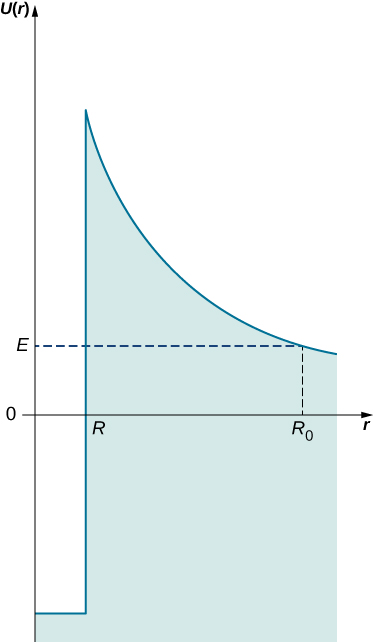
Figure 7.7.37.7.3: The potential energy barrier for an α-particle bound in the nucleus: To escape from the nucleus, an α-particle with energy EE must tunnel across the barrier from distance RR to distance R0R0 away from the center.
Field Emission
Field emission is a process of emitting electrons from conducting surfaces due to a strong external electric field that is applied in the direction normal to the surface (Figure 7.7.47.7.4). As we know from our study of electric fields in earlier chapters, an applied external electric field causes the electrons in a conductor to move to its surface and stay there as long as the present external field is not excessively strong. In this situation, we have a constant electric potential throughout the inside of the conductor, including its surface. In the language of potential energy, we say that an electron inside the conductor has a constant potential energy U(x)−−U0U(x)−−U0 (here, the x means inside the conductor).
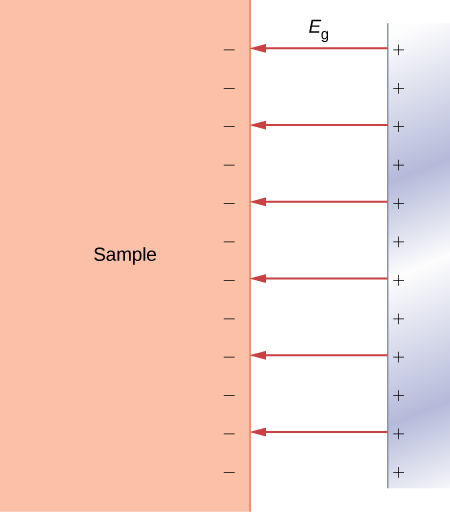
Figure 7.7.47.7.4: A normal-direction external electric field at the surface of a conductor: In a strong field, the electrons on a conducting surface may get detached from it and accelerate against the external electric field away from the surface.
In the situation represented in Figure 7.7.47.7.4, where the external electric field is uniform and has magnitude EgEg, if an electron happens to be outside the conductor at a distance x away from its surface, its potential energy would have to be U(x)=−eEgxU(x)=−eEgx (here, x denotes distance to the surface). Taking the origin at the surface, so that x=0x=0 is the location of the surface, we can represent the potential energy of conduction electrons in a metal as the potential energy barrier shown in Figure 7.7.57.7.5. In the absence of the external field, the potential energy becomes a step barrier defined by U(x≤0)=−U0U(x≤0)=−U0 and by U(x>0)=0U(x>0)=0.
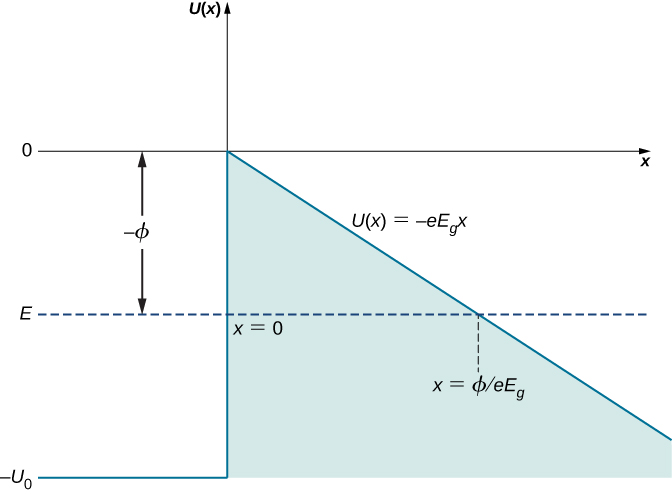
Figure 7.7.57.7.5: The potential energy barrier at the surface of a metallic conductor in the presence of an external uniform electric field EgEg normal to the surface: It becomes a step-function barrier when the external field is removed. The work function of the metal is indicated by ϕ.
When an external electric field is strong, conduction electrons at the surface may get detached from it and accelerate along electric field lines in a direction antiparallel to the external field, away from the surface. In short, conduction electrons may escape from the surface. The field emission can be understood as the quantum tunneling of conduction electrons through the potential barrier at the conductor’s surface. The physical principle at work here is very similar to the mechanism of α-emission from a radioactive nucleus.
Suppose a conduction electron has a kinetic energy E (the average kinetic energy of an electron in a metal is the work function ϕ for the metal and can be measured, as discussed for the photoelectric effect in Photons and Matter Waves), and an external electric field can be locally approximated by a uniform electric field of strength EgEg. The width L of the potential barrier that the electron must cross is the distance from the conductor’s surface to the point outside the surface where its kinetic energy matches the value of its potential energy in the external field. In Figure 7.7.57.7.5, this distance is measured along the dashed horizontal line U(x)=EU(x)=E from x=0x=0 to the intercept with U(x)=−eEgxU(x)=−eEgx, so the barrier width is
L=e−1EEg=e−1ϕEg(7.7.31)(7.7.31)L=e−1EEg=e−1ϕEg
We see that L is inversely proportional to the strength EgEg of an external field. When we increase the strength of the external field, the potential barrier outside the conductor becomes steeper and its width decreases for an electron with a given kinetic energy. In turn, the probability that an electron will tunnel across the barrier (conductor surface) becomes exponentially larger. The electrons that emerge on the other side of this barrier form a current (tunneling-electron current) that can be detected above the surface. The tunneling-electron current is proportional to the tunneling probability. The tunneling probability depends nonlinearly on the barrier width L, and L can be changed by adjusting EgEg. Therefore, the tunneling-electron current can be tuned by adjusting the strength of an external electric field at the surface. When the strength of an external electric field is constant, the tunneling-electron current has different values at different elevations L above the surface.
SCANNING TUNNELING MICROSCOPE
The quantum tunneling phenomenon at metallic surfaces, which we have just described, is the physical principle behind the operation of the scanning tunneling microscope (STM), invented in 1981 by Gerd Binnig and Heinrich Rohrer. The STM device consists of a scanning tip (a needle, usually made of tungsten, platinum-iridium, or gold); a piezoelectric device that controls the tip’s elevation in a typical range of 0.4 to 0.7 nm above the surface to be scanned; some device that controls the motion of the tip along the surface; and a computer to display images. While the sample is kept at a suitable voltage bias, the scanning tip moves along the surface (Figure 7.7.67.7.6) and the tunneling-electron current between the tip and the surface is registered at each position.

Figure 7.7.67.7.6: In STM, a surface at a constant potential is being scanned by a narrow tip moving along the surface. When the STM tip moves close to surface atoms, electrons can tunnel from the surface to the tip. This tunneling-electron current is continually monitored while the tip is in motion. The amount of current at location (x,y) gives information about the elevation of the tip above the surface at this location. In this way, a detailed topographical map of the surface is created and displayed on a computer monitor.
The amount of the current depends on the probability of electron tunneling from the surface to the tip, which, in turn, depends on the elevation of the tip above the surface. Hence, at each tip position, the distance from the tip to the surface is measured by measuring how many electrons tunnel out from the surface to the tip. This method can give an unprecedented resolution of about 0.001 nm, which is about 1% of the average diameter of an atom. In this way, we can see individual atoms on the surface, as in the image of a carbon nanotube in Figure 7.7.77.7.7.

Figure 7.7.77.7.7: An STM image of a carbon nanotube: Atomic-scale resolution allows us to see individual atoms on the surface. STM images are in gray scale, and coloring is added to bring up details to the human eye.
Resonant Quantum Tunneling
Quantum tunneling has numerous applications in semiconductor devices such as electronic circuit components or integrated circuits that are designed at nanoscales; hence, the term ‘nanotechnology.’ For example, a diode (an electric-circuit element that causes an electron current in one direction to be different from the current in the opposite direction, when the polarity of the bias voltage is reversed) can be realized by a tunneling junction between two different types of semiconducting materials. In such a tunnel diode, electrons tunnel through a single potential barrier at a contact between two different semiconductors. At the junction, tunneling-electron current changes nonlinearly with the applied potential difference across the junction and may rapidly decrease as the bias voltage is increased. This is unlike the Ohm’s law behavior that we are familiar with in household circuits. This kind of rapid behavior (caused by quantum tunneling) is desirable in high-speed electronic devices.
Another kind of electronic nano-device utilizes resonant tunneling of electrons through potential barriers that occur in quantum dots. A quantum dot is a small region of a semiconductor nanocrystal that is grown, for example, in a silicon or aluminum arsenide crystal. Figure 7.7.8a7.7.8a shows a quantum dot of gallium arsenide embedded in an aluminum arsenide wafer. The quantum-dot region acts as a potential well of a finite height (Figure 7.7.8b7.7.8b) that has two finite-height potential barriers at dot boundaries. Similarly, as for a quantum particle in a box (that is, an infinite potential well), lower-lying energies of a quantum particle trapped in a finite-height potential well are quantized. The difference between the box and the well potentials is that a quantum particle in a box has an infinite number of quantized energies and is trapped in the box indefinitely, whereas a quantum particle trapped in a potential well has a finite number of quantized energy levels and can tunnel through potential barriers at well boundaries to the outside of the well. Thus, a quantum dot of gallium arsenide sitting in aluminum arsenide is a potential well where low-lying energies of an electron are quantized, indicated as EdotEdot in part (b) in the figure. When the energy EelectronEelectron of an electron in the outside region of the dot does not match its energy EdotEdot that it would have in the dot, the electron does not tunnel through the region of the dot and there is no current through such a circuit element, even if it were kept at an electric voltage difference (bias). However, when this voltage bias is changed in such a way that one of the barriers is lowered, so that EdotEdot and EelectronEelectron become aligned, as seen in part (c) of the figure, an electron current flows through the dot. When the voltage bias is now increased, this alignment is lost and the current stops flowing. When the voltage bias is increased further, the electron tunneling becomes improbable until the bias voltage reaches a value for which the outside electron energy matches the next electron energy level in the dot. The word ‘resonance’ in the device name means that the tunneling-electron current occurs only when a selected energy level is matched by tuning an applied voltage bias, such as in the operation mechanism of the resonant-tunneling diode just described. Resonant-tunneling diodes are used as super-fast nano-switches.
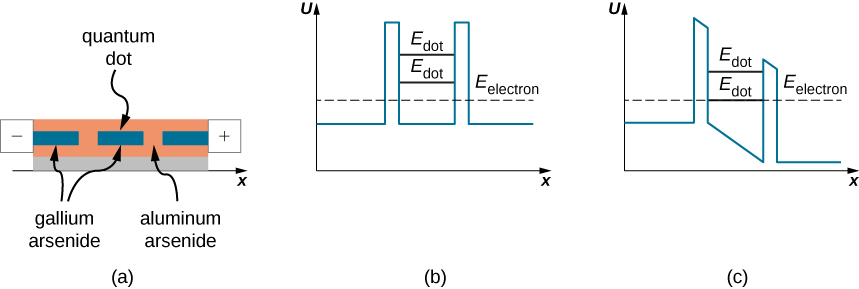
Figure 7.7.87.7.8: Resonant-tunneling diode: (a) A quantum dot of gallium arsenide embedded in aluminum arsenide. (b) Potential well consisting of two potential barriers of a quantum dot with no voltage bias. Electron energies EelectronEelectron in aluminum arsenide are not aligned with their energy levels EdotEdot in the quantum dot, so electrons do not tunnel through the dot. (c) Potential well of the dot with a voltage bias across the device. A suitably tuned voltage difference distorts the well so that electron-energy levels in the dot are aligned with their energies in aluminum arsenide, causing the electrons to tunnel through the dot.
Contributors
Samuel J. Ling (Truman State University), Jeff Sanny (Loyola Marymount University), and Bill Moebs with many contributing authors. This work is licensed by OpenStax University Physics under a
Creative Commons Attribution License (by 4.0).
Creative Commons Attribution License (by 4.0).
Recommended articles
3.3 Energy-Time Uncertainty PrincipleThe momentum-position uncertainty principle Δp⋅Δx≥ℏ has an energy-time analog, ΔE⋅Δt≥ℏ. Evidently, though, this must be a different kind of relation...
28.2: Applications of Quantum MechanicsFluorescence and phosphorescence are photoluminescence processes in which material emits photons after excitation.
7.1: Prelude to Quantum MechanicsThe quantum-computer processor is the “brain” of a quantum computer that operates at near-absolute zero temperatures. Unlike a digital computer, which...
7.2: Wave functionsIn quantum mechanics, the state of a physical system is represented by a wave function. In Born’s interpretation, the square of the particle’s wave fu...


